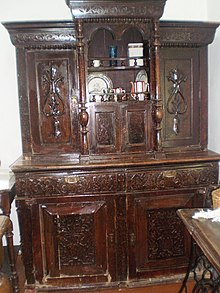Wreath (cupboard)
As ring is in cabinets decorative strip designated at the top of the furniture. Historically, it is the successor to classic cornices, which were mainly used to decorate the cupboards.
history
The term cornice originally comes from architecture and describes the final cornice at the top of a building. The cornice is a protruding element that is often decorated with elaborate decorations. In addition, the term refers to the geisa of Roman and Greek architecture, i.e. the protruding cornices of the buildings from this period.
The term found its way into furniture construction, as the cornices of antique wooden cupboards are strongly reminiscent of the cornices from architecture. Elaborate decorative elements were also incorporated into the cornices. In addition to coats of arms and emblems , the bride's name was often found in dowry cupboards . Traditionally, the cornice was a separate, box-shaped component that was placed on the body . Even today, wreaths reminiscent of the old construction can be found in furniture construction. In contrast to the ancient predecessors, these are no longer as splendid and protruding, but rather serve to accentuate the cupboards. For example, by highlighting them in color.
Today's modern wreaths no longer have much in common with their predecessors. The wreath is limited to a small, slightly protruding bar on the front of the cabinet, which often illuminates the inside of the cabinet with integrated lighting.
function
Traditionally, the cornices served more aesthetic purposes and the expression of craftsmanship. In addition, the coats of arms and names worked into the decorations revealed the affiliation of the cabinet. However, they were also a means of customizing the cabinets.
Today the focus is more on practical use. The wreaths are only mounted as a strip on the front side and no longer protrude as far. This means that the cabinet can be placed precisely against the wall. In addition, lamps can be installed in the strips to illuminate the interior.
Web links
Individual evidence
- ↑ Wolfgang Nutsch: Handbook of construction: furniture and built-in cupboards . Ed .: Random House GmbH. 1st edition. DVA Dt.Verlags-Anstalt, 2015, ISBN 978-3-421-04019-0 , p. 432 .
- ↑ Kristina Schelinski: Four baroque cabinets from the Germanic National Museum in Nuremberg, comparative art-technological investigation and dimensional analysis. Technical University of Munich, September 30, 2009, accessed on September 18, 2017 .

